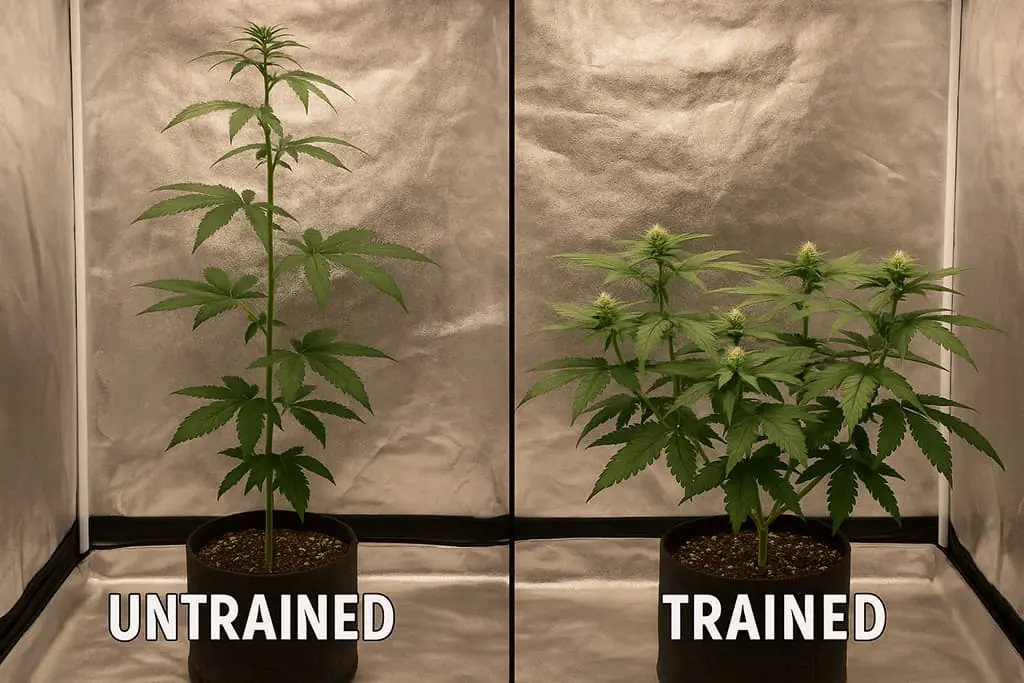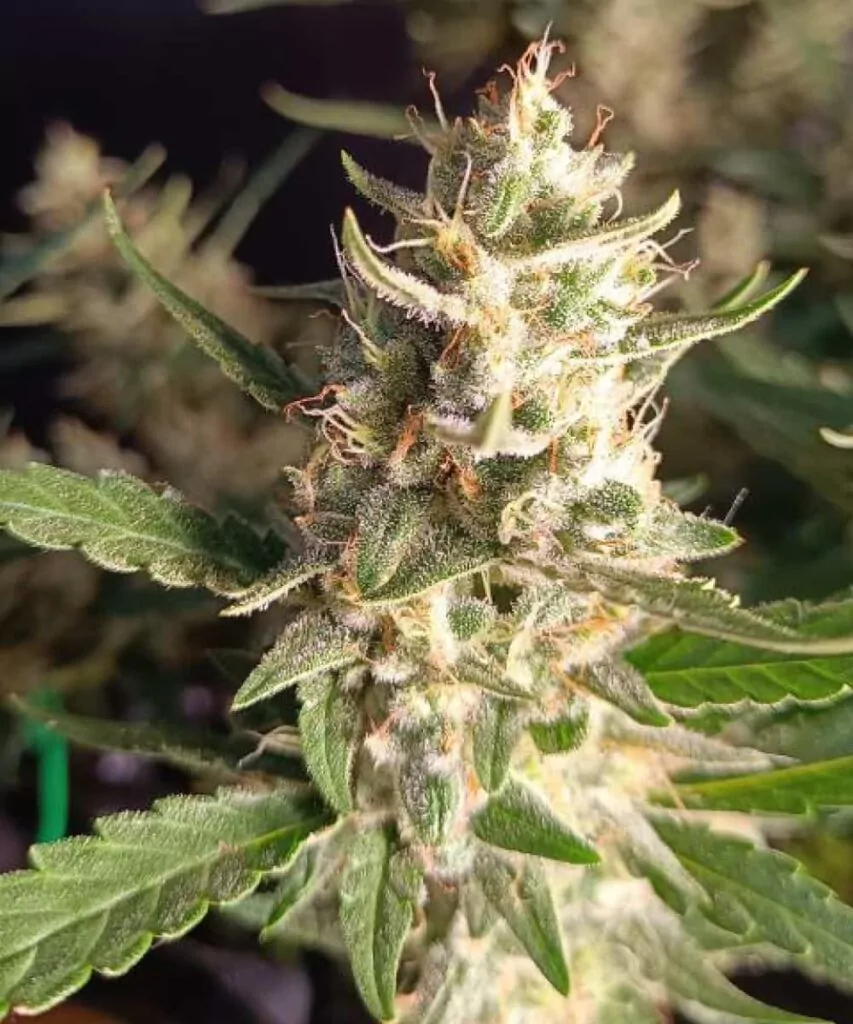Training Cannabis Plants 101: The Clear Guide to LST & HST

If you’ve ever wondered why some cannabis plants look like perfect flat-topped bushes while others shoot straight up like Christmas trees, the secret is training.
Plant training is simply shaping your plant’s growth so it uses light more efficiently, grows stronger, and produces bigger yields. It’s not magic, it’s a set of proven techniques you can learn in one grow cycle.
In this guide, we’ll map out every major cannabis training method, show you when to use it, and explain it in plain language. You’ll get a bird’s-eye view first, then you can dive deeper into any technique with our detailed grow guides.

The Big Map: Cannabis Training Overview
Cannabis training falls into two main families:
- LST (Low Stress Training) – gentle methods that bend or guide branches without damaging the plant’s tissue.
- HST (High Stress Training) – more intense techniques involving cutting, pinching, or significant stress that temporarily slows growth before boosting it.
Understanding which family a technique belongs to helps you plan your grow: LST keeps plants in steady growth, while HST can reshape them quickly but needs recovery time.
🌵 LST (Low Stress Training)
Gentle methods that bend, tie, or guide branches without harming plant tissue. They keep growth steady and are safe for both autos and photos.
🔗 Check the full LST guide here
Techniques:
- Tie-Down / Bending – Bend branches outward and secure them with ties.
- SCROG (Screen of Green) – Use a net to guide branches into a flat, even canopy.
- Leaf Tucking – Fold large leaves under to expose lower bud sites.
- Ponytailing – Temporarily tie top leaves together to let light reach lower growth.
- Spiral Training – Wrap the main stem around the pot for compact, even growth.
- Staking / Plant Yo-Yos – Use supports to angle branches or prevent bud droop.
✂️ HST (High Stress Training)
More aggressive techniques that involve cutting, pinching, or stressing the plant. They can reshape growth quickly but require recovery time, making them best for photoperiod plants.
🔗 Check the full HST guide here
Techniques:
- Topping – Remove the main growth tip to create two main stems.
- FIM – Partially pinch the top to produce 2–4 new shoots.
- Mainlining / Manifolding – Combine topping and LST to create a perfectly symmetrical plant structure.
- Supercropping – Crush the inner stem and bend it to control height and strengthen growth.
- Lollipopping – Remove lower branches to focus energy on top colas.
- Defoliation – Remove specific fan leaves to improve airflow and light penetration.
- Schwazzing – Aggressive defoliation at specific times in flower.
- Monster Cropping – Take clones from a flowering plant for bushy regrowth.
- Backbuilding – Trim the tip of a forming bud to encourage density (controversial).
Cannabis Training: Quick Reference Table
This table puts every major technique side by side so you can quickly see what it does, when to use it, and how much stress it puts on your plants.
LST Techniques
| Technique | What It Is | Main Goal | Best Stage | Best For | Risk |
|---|---|---|---|---|---|
| Tie-Down / Bending | Bend & tie branches outward | Even canopy, better light use | Early–Mid Veg | All plants, small spaces | 🌱 |
| SCROG | Guide branches through a net | Max yield per light area | Late Veg–Early Flower | Photos, tents | ⚠️ |
| Leaf Tucking | Fold large leaves under bud sites | Light exposure w/out cutting | Any Veg/Early Flower | All plants | 🌱 |
| Ponytailing | Tie top leaves together temporarily | Stimulate lower growth | Early Veg | Bushier growth | 🌱 |
| Spiral Training | Wrap main stem around pot | Compact, even growth | Early–Mid Veg | Micro-grows | 🌱 |
| Staking / Yo-Yos | Support or angle branches | Prevent bud droop, open canopy | Veg–Late Flower | Heavy bud strains | 🌱 |
HST Techniques
| Technique | What It Is | Main Goal | Best Stage | Best For | Risk |
|---|---|---|---|---|---|
| Topping | Remove main growth tip | Create multiple main stems | Early–Mid Veg | Photos, long veg | ⚠️ |
| FIM | Pinch top, leaving part of tip | 2–4 new tops | Early–Mid Veg | Photos | ⚠️ |
| Mainlining / Manifolding | Topping + LST symmetry | Perfect multi-cola plant | Early Veg | Photos, long veg | 🔥 |
| Supercropping | Crush stem & bend at 90° | Control height, strengthen stems | Late Veg–Early Flower | Tall, vigorous plants | ⚠️ |
| Lollipopping | Remove lower third of branches | Focus on top colas | Late Veg–Week 2 Flower | Dense grows, SCROG | ⚠️ |
| Defoliation | Remove select fan leaves | Airflow, light penetration | Late Veg–Early Flower | Humid rooms, leafy strains | ⚠️ |
| Schwazzing | Aggressive timed defoliation | Reset canopy for dense SCROG | Flip & Day 21 Flower | Experienced SCROG growers | 🔥 |
| Monster Cropping | Clone from flowering plant | Bushy regrowth from clone | Early Flower (Weeks 2–3) | Perpetual growers | ⚠️ |
| Backbuilding | Snip bud tip mid-flower | Denser bud structure (debated) | Mid Flower | Experimental grows | ⚠️ |
Cannabis Training: Timing Graph
One of the biggest mistakes new growers make is using the right technique at the wrong time.
This timing guide shows exactly when each method works best, so you don’t slow down growth or hurt your harvest.
Seedling (Weeks 1–2)
- No structural training, only gentle leaf tucking if needed.
Early Veg (Weeks 3–5)
- LST: Tie-Down, Spiral Training, Ponytailing, Leaf Tucking.
- HST: First Topping or FIM, Start Mainlining/Manifolding.
Mid Veg (Weeks 5–7)
- LST: Continue Tie-Down, SCROG setup, Staking/Yo-Yos.
- HST: Second Topping (if needed), Supercropping tall leaders, Begin Lollipopping.
Pre-Flower (Last Week of Veg)
- LST: Final SCROG adjustments, Canopy shaping.
- HST: Finish Lollipopping, Light Defoliation.
Early Flower / Stretch (Weeks 1–3)
- LST: Maintain SCROG fill, Support heavy branches.
- HST: Final Defoliation (end of week 2), Schwazzing (advanced only).
Mid–Late Flower (Weeks 4–8+)
- No structural training, only Staking/Yo-Yos for support, minimal leaf removal if blocking bud sites.
- Optional: Backbuilding in mid flower (week 4–5).
Choosing LST vs HST
Choosing the right training style depends on your plant type, grow space, and how much recovery time you can give. Here’s a quick decision guide:
🌵 LST is best if…
- You’re growing autoflowers (short life cycle, less recovery time).
- You want steady growth without slowdown.
- Your space is small, and you need to keep plants low.
- You prefer a safer, beginner-friendly approach.
✂️ HST is best if…
- You’re growing photoperiod plants with at least 6–8 weeks of veg.
- You want maximum control over plant structure.
- You can give plants several days to recover after training.
- You enjoy more advanced, hands-on techniques.
Hybrid Approach (LST + HST)
Many growers combine both:
- Start with HST early in veg (topping, mainlining).
- Maintain shape with LST (tie-downs, SCROG) through late veg and early flower.
Mini-Technique Cards
These short cards give you the what, when, and why for each technique in 20 seconds or less.
🌵 LST (Low Stress Training)
🔗 Want the full walkthrough? Read our complete LST training guide.
Tie-Down / Bending
- What: Bend branches outward and tie in place.
- When: Early–mid veg.
- Why: Creates an even canopy and better light penetration.
- Risk: 🌱 Low
- Best For: All plants, small spaces.
SCROG (Screen of Green)
- What: Guide branches through a net for a flat canopy.
- When: Late veg–early flower.
- Why: Maximizes yield per light area.
- Risk: ⚠️ Medium
- Best For: Photoperiods, tents.
Leaf Tucking
- What: Fold large leaves under bud sites instead of cutting.
- When: Any veg or early flower.
- Why: Increases light exposure without stress.
- Risk: 🌱 Very Low
- Best For: All growers.
Ponytailing
- What: Temporarily tie top leaves together.
- When: Early veg.
- Why: Boosts lower branch growth.
- Risk: 🌱 Low
- Best For: Bushier plants.
Spiral Training
- What: Wrap main stem around pot edge.
- When: Early–mid veg.
- Why: Keeps plants short with multiple tops.
- Risk: 🌱 Low
- Best For: Micro-grows.
Staking / Yo-Yos
- What: Support or angle branches with stakes or plant yo-yos.
- When: Veg–late flower.
- Why: Prevents bud droop, opens canopy.
- Risk: 🌱 Very Low
- Best For: Heavy-flowering strains.
✂️ HST (High Stress Training)
🔗 Want the full walkthrough? Read our complete HST training guide.
Topping
- What: Cut off main tip above a node.
- When: Early–mid veg.
- Why: Creates two main stems and more colas.
- Risk: ⚠️ Medium
- Best For: Photos with long veg.
FIM
- What: Pinch ~70–80% of the top.
- When: Early–mid veg.
- Why: Produces 2–4 tops with less slowdown than topping.
- Risk: ⚠️ Medium
- Best For: Photos.
Mainlining / Manifolding
- What: Structured topping + LST for perfect symmetry.
- When: Early veg.
- Why: Produces multiple even colas.
- Risk: 🔥 High
- Best For: Photos, long veg.
Supercropping
- What: Crush inner stem and bend at 90°.
- When: Late veg–early flower.
- Why: Controls height, strengthens stems.
- Risk: ⚠️ Medium
- Best For: Tall, vigorous plants.
Lollipopping
- What: Remove lower third of branches.
- When: Late veg–week 2 flower.
- Why: Focuses growth on top colas.
- Risk: ⚠️ Medium
- Best For: Dense SOG or SCROG.
Defoliation
- What: Remove select fan leaves.
- When: Late veg–early flower.
- Why: Improves airflow and light penetration.
- Risk: ⚠️ Medium
- Best For: Humid or leafy grows.
Schwazzing
- What: Aggressive timed defoliation.
- When: Flip day & day 21 flower.
- Why: Opens canopy for dense SCROG buds.
- Risk: 🔥 High
- Best For: Experienced growers.
Backbuilding
- What: Snip bud tip mid-flower.
- When: Mid flower (week 4–5).
- Why: Claimed to increase bud density.
- Risk: ⚠️ Medium
- Best For: Experimental grows.
Monster Cropping
- What: Clone from a flowering plant.
- When: Early flower (weeks 2–3).
- Why: Produces bushy clones with many bud sites.
- Risk: ⚠️ Medium
- Best For: Perpetual growers.
Safety & Recovery Rules
Training can supercharge your yield, but only if the plant is healthy enough to handle it.
Follow these rules to keep your plants thriving after LST or HST.
Before Training
- ✅ Healthy plants only — Avoid training sick, pest-infested, or nutrient-deficient plants.
- ✅ Hydrate first — Train when plants are well-watered to reduce snapping.
- ✅ Work near lights-on — Plants are more flexible and responsive early in the light cycle.
- ✅ Clean your tools — Disinfect scissors, blades, or hands to prevent infections.
During Training
- ✅ Bend gradually — Especially with older, woody stems.
- ✅ Support heavy bends — Use stakes or ties to hold shape.
- ✅ Monitor daily — Adjust ties as stems thicken to avoid cutting into them.
- ❌ Don’t remove more than 20–25% foliage at once (except in planned advanced techniques like schwazzing).
- ❌ Don’t over-train autos — Their short life cycle leaves little room for recovery.
After Training
- ✅ Give recovery time — Wait 2–5 days after HST before stressing again.
- ✅ Boost airflow — Reduces risk of mold in freshly opened canopies.
- ✅ Consider silica supplements — Strengthens stems for future training.
- ❌ Avoid heavy watering right after HST — Let the plant focus on healing.
Stop Training Completely
- End HST by week 2 of flower (for photos).
- LST can continue lightly until the end of the flower stretch, then stop.
FAQ
What is cannabis training?
Cannabis training is the process of shaping a plant’s growth to improve light exposure, airflow, and yield. It involves bending, tying, or pruning branches to create an even canopy and more bud sites.
What is the difference between LST and HST in cannabis growing?
LST (Low Stress Training) uses gentle bending and tying without harming plant tissue, keeping growth steady. HST (High Stress Training) involves cutting or damaging stems, which slows growth temporarily but can produce bigger yields with recovery time.
Is LST safe for autoflowers?
Yes! LST is ideal for autoflowers because it doesn’t cause significant recovery delays. Most growers avoid HST on autos due to their short vegetative period.
When should I start training cannabis plants?
Begin training in early vegetative growth, once plants have at least 4–6 nodes. Start with LST techniques like tie-downs or leaf tucking, and apply HST like topping early enough for full recovery before flowering.
Can I combine LST and HST?
Yes! Many growers start with HST (topping, mainlining) early in veg, then maintain shape with LST (tie-downs, SCROG) through the rest of veg and early flower.
What training methods give the highest yields?
SCROG, mainlining, and a well-timed combination of LST and HST generally produce the largest harvests, especially in photoperiod plants with a long veg phase.
How late in flowering can I train cannabis plants?
Stop HST by week 2 of flower. LST adjustments can continue until the end of the stretch, but avoid heavy manipulation once buds are forming.
What tools do I need for cannabis training?
Basic tools include soft plant ties, garden wire, scissors, pruning snips, stakes, plant yo-yos, and optionally a SCROG net.














